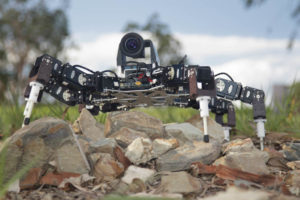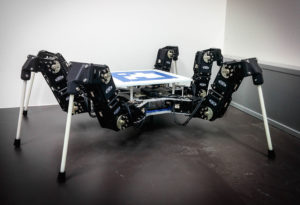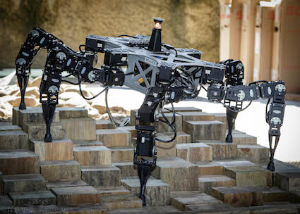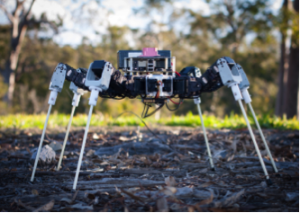Syropods: CSIRO’s hexapod robots
Drawing inspiration from nature, legged robots are capable of traversing unstructured terrain inaccessible to most wheeled and tracked robots. They provide a means for observing remote environments, inspecting confined spaces, assisting first responders in the aftermath of disasters as well as tending to our crop fields of the future.
What do we do?
At CSIRO, we use our fleet of Syropods (CSIRO hexapod robots) to develop component techniques and capabilities required by robots to perform real-world missions. These missions range from inspecting confined spaces in the manufacturing industry, traversing, sensing and monitoring unstructured terrain (eg. collapsed buildings/mines, rainforests). These environments are typically hazardous for humans to operate in. Legged robots have an advantage over wheeled counterparts in being able to climb over obstacles and not disturb the surface in the process. Other potential applications would be in agriculture where fleets of autonomous legged robots can do crop monitoring and management without compacting the soil and damaging the crop.

Zee

Baldwin

Weaver

Harvey
Energetics based gait switching
Legged robots can use many different walking pattern or gaits for locomotion. Each of these gaits has different properties such as speed, energy consumption and ground traction. Different terrains and different mission objectives require appropriate gaits to maintain traversal efficiency. Consequently, as a legged robot transitions from one type of terrain to another, the gait pattern should be adapted so as to maximise traction and energy efficiency. One of our research threads explores the use of power consumption as estimated by the robot in real-time for guiding this gait transition. We have developed a technique where the robot autonomously assesses its power consumption, relates it to the traction, and switches between gaits to maintain traversal efficiency. We have tested this approach on a hexapod robot traversing a variety of terrain types and stiffness, including concrete, grass, mulch and leaf litter. Our results show that gait switching on energetics alone enables traction maintenance and efficient locomotion across different terrains
Stabilisation in unstructured terrain
Being able to detect leg slips and recover from them is an important aspect of navigating in rough and unstructured terrain. When the terrain is either well known ahead of time (accurate terrain model known a priori) or is accurately observed by on-board sensors, motion planning algorithms can be used by the robot for navigation and maintaining stability. However, unexpected leg disturbances could occur due to inadequacies in the terrain model or sensors or simply due to the dynamic nature of the terrain (eg. loose soil/rocks, debris, sand).
We have developed a state space based framework for stabilisation of a high dimensional multi-legged robot which detects and recovers from unexpected events such as leg slip. We have tested this approach using a hexapod robot with extended limbs. Our results show that roll and pitch stability is improved significantly when using this method
Motion planning for legged robots
Legged robots such as hexapods are highly flexible robotic platforms due to their high degrees of freedom. However the high degrees of freedom also introduce challenges in navigation and control especially in complex environments like rocky terrains, soft soil, in confined spaces etc. We are actively researching on state of the art motion planning techniques to enable stable sensor payload navigation through these complex terrains.
Related projects
Weaver: Hexapod robot with 5DoF limbs for navigating on unstructured terrain
Related papers
- Dylan Williamson, Navinda Kottege, & Peyman Moghadam, (2016), Terrain Characterisation and Gait Adaptation by a Hexa-pod Robot. In proceedings of the Australasian Conference on Robotics & Automation (ACRA 2016), Brisbane, QLD.
[Abstract][Paper] Download citation [BibTex] - Marko Bjelonic, Navinda Kottege, & Philipp Beckerle, (2016), Proprioceptive Control of an Over-Actuated Hexapod Robot in Unstructured Terrain, In proceedings of the IEEE/RSJ International Conference on Intelligent Robots and Systems (IROS 2016), Daejeon, Korea, October, 2016.
[Abstract][Paper] Download citation [BibTex] - Timon Homberger, Marko Bjelonic, Navinda Kottege, & Paulo Borges, (2016), Terrain-dependant Control of Hexapod Robots using Vision, In proceedings of the International Symposium on Experimental Robotics (ISER 2016), Tokyo, Japan, October 2016.
[Abstract][Paper] Download citation [BibTex] - Joshua Christie and Navinda Kottege, (2016), Acoustics based Terrain Classification for Legged Robots. In proceedings of the IEEE International Conference on Robotics and Automation (ICRA 2016), Stockholm, Sweden, May, 2016
[Abstract][Paper] Download citation [BibTex] - Navinda Kottege, Callum Parkinson, Peyman Moghadam, Alberto Elfes & Surya P. N. Singh (2015), Energetics-Informed Hexapod Gait Transitions. In proceedings of the IEEE International Conference on Robotics and Automation (ICRA 2015), Seattle, WA, USA, May 26-30, 2015
[Abstract][Paper] Download citation [BibTex] - Marcus Hoerger, Navinda Kottege, Tirthankar Bandyopadhyay, Alberto Elfes & Peyman Moghadam (2014), Real-time Stabilisation for Hexapod Robots. In proceedings of the International Symposium on Experimental Robotics (ISER 2014), Marrakech and Essaouira, Morocco, June 15-18, 2014
[Abstract][Paper] Download citation [BibTex] - Graeme Best, Peyman Moghadam, Navinda Kottege, & Lindsay Kleeman (2013), Terrain Classification Using a Hexapod Robot. In proceedings of the Australasian Conference on Robotics and Automation 2013 (ACRA ’13), Sydney, Australia, December 2013. ISBN: 978-0-9807404-4-8
[Abstract][Paper]
